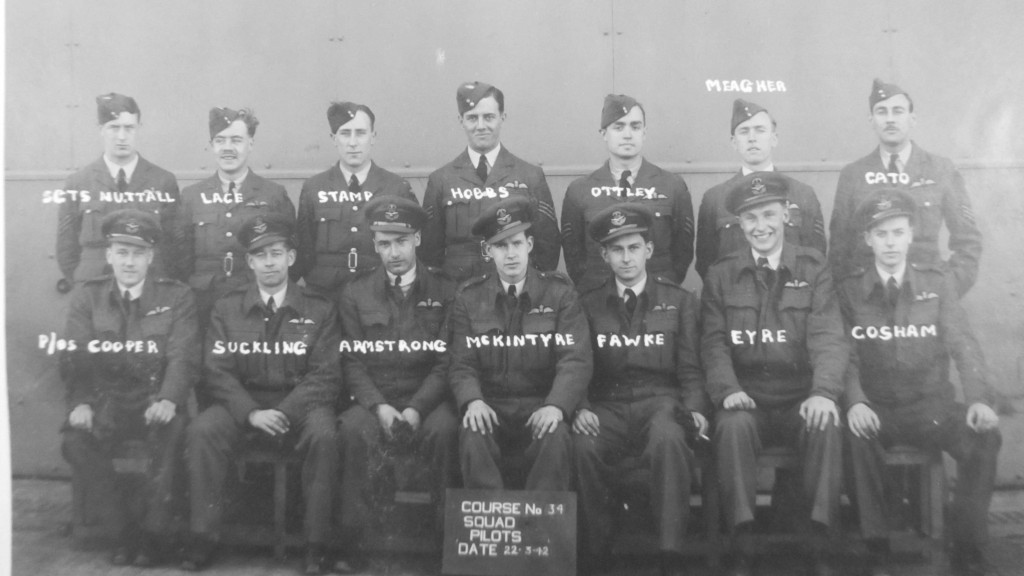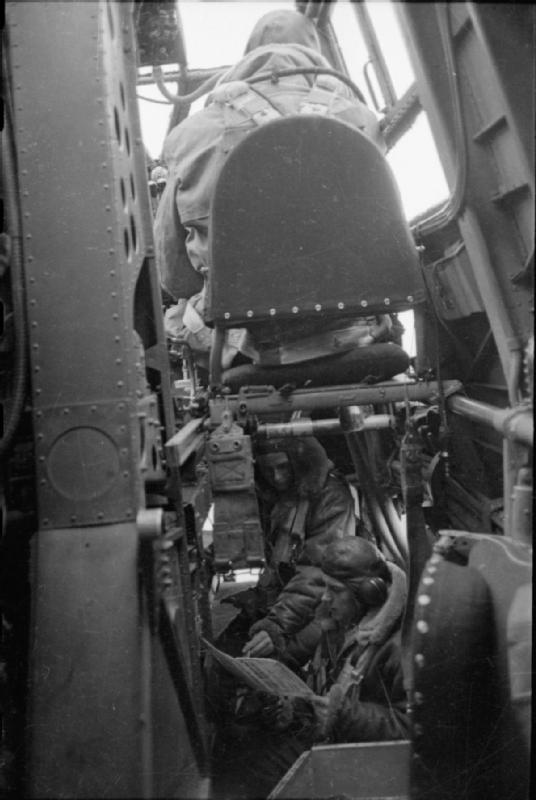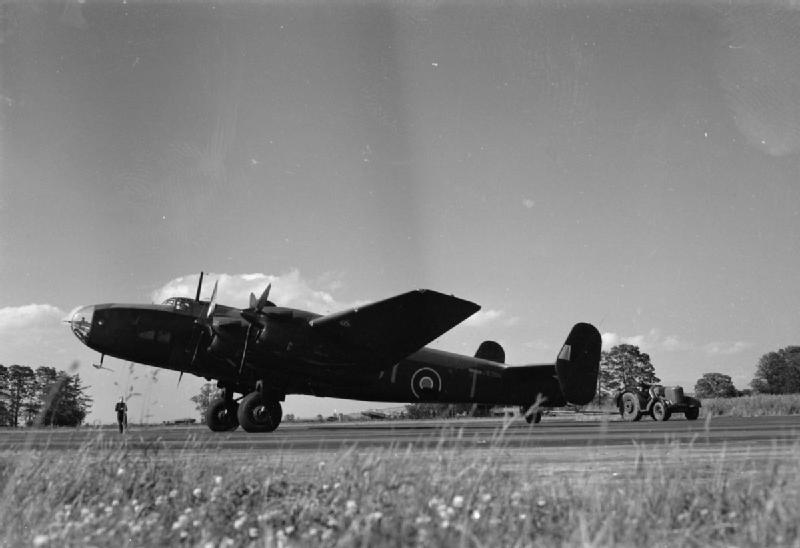RAF Service History of F/Sgt Percy Cato
Many thanks to Geoff King (relative of Captain P/O Geoffrey King) compiler of the following information.

Percy Cato was on the 19 OTU Pilots course No 34 dated 22 Mar 1942 and was posted to 102 Squadron
It seems his first operational flight was as second pilot to Captain P/O Geoffrey King and his crew to Bremen 4/5 Sept 1942 in Halifax W.1247 DY-A, which was one of 6 aircraft detailed for the attack. The weather was clear no cloud with good visibility with some ground haze. There was intense light and heavy flak and numerous searchlights working in cones. They took off at 23.51 and returned at 05.23. They attacked the primary target at 14,500 ft. and observed that their bombs seemed to burst in the old town west of the bridge on both side of the river. Their incendiaries seemed to start scattered fires. They landed at Waterbeach Airfield.
Aircraft on the raid: 251 aircraft – 98 Wellingtons, 76 Lancasters, 41 Halifaxes, 36 Stirlings. 12 aircraft – 7 Wellingtons, 3 Lancasters, 1 Halifax, 1 Stirling – lost, 4.8 per cent of the force.
Bomber Command reported: The Pathfinders introduced new techniques on this night, splitting their aircraft into 3 forces: ‘illuminators’, who lit up the area with white flares; ‘visual markers’, who dropped coloured flares if they had identified the aiming point; then ‘backers-up’, who dropped all-incendiary bomb loads on to the coloured flares. This basic pattern – illuminating, marking and backing-up – would form the basis of most future Pathfinder operations with proper target-indicator bombs and various electronic bombing aids being employed as they became available. The weather was clear and the Pathfinder plan worked well; heavy bombing of the target followed. Bremen confirms that this was a successful raid. Among the industrial buildings seriously hit were the Weser aircraft works and the Atlas shipyard. 4 dockside warehouses were destroyed and 3 oil-storage tanks were burnt out. Various public buildings together with 7 schools and 3 hospitals were hit. 124 people were killed and 470 injured.

Inside a Halifax fuselage from the rear showing the second pilot on his seat with the navigator under him and the front gunner in position
Sgt Cato’s second operation was also as second pilot to Captain P/O Geoffrey King and his crew to Frankfurt 8/9 Sept 1942 in Halifax W.1247 DY-A, one of 11 aircraft detailed for the attack. The weather had a small amount of cloud but with thick ground haze. There was moderate light and heavy flak and numerous searchlights. They took off at 20.35 and returned at 04.02. They bombed on E.T.A. at 15,000 ft. They saw bursts and large fires south of the river.
Aircraft on the raid: 249 aircraft of 5 types. 5 Wellingtons and 2 Halifaxes lost, 2.8 per cent of the force. Bomber Command reported: The Pathfinders were unable to locate Frankfurt accurately and most of the bombing fell south-west of the city and in the town of Russelsheim, 15 miles away. Frankfurt reports only a few bombs – approximately 6 aircraft loads – with minor damage, 1 person dead and 30 injured. Bomber Command documents state that the Opel tank factory and the Michelin tyre factory were damaged.
Sgt. Cato’s third operation was as second pilot to P/O L.G Mee and his crew in Halifax W.1181 DY-D one of ten 102 Sqn aircraft detailed to attack Dusseldorf on 10/11 Sept 1942. The weather was thick industrial haze over the target and the opposition was co-operating light and heavy flak. He took off from Pocklington at 20.04 and returned at 01.30 – They attacked the Primary target at 15,000 ft and were held by searchlights so bombed on GEE. One 102 Sqn aircraft went missing on this raid Halifax W.7752 DY- R flown by P/O B.G.H. Smith and his crew. P/O Geoffrey King and his crew were also on this raid in Halifax W.1271 DY-C.
Aircraft on Raid: 479 aircraft – 242 Wellingtons, 89 Lancasters, 59 Halifaxes, 47 Stirlings, 28 Hampdens, 14 Whitleys, Training aircraft of 91, 92 and 93 Groups took part in this raid. 33 aircraft – 20 Wellingtons, 5 Lancasters, 4 Stirlings, 3 Halifaxes and 1 Hampden were lost, 7.1% of the force. 16 OTU from Upper Heyford, lost 5 of its 13 Wellingtons on the raid. Bomber Command reported: The Pathfinders successfully marked the target, using ‘Pink Pansies’ in converted 4,000 lb bomb casings for the first time. All parts of Dusseldorf except the north of the city were hit as well as the neighbouring town of Neuss. 39 Industrial firms in Dusseldorf and 13 in Neuss were damaged so much that all production ceased for various periods. 8 public buildings were destroyed and 67 damaged. 911 houses were destroyed and 1,506 seriously and 8,340 lightly damaged. 132 people were killed, 120 in Dusseldorf and 12 in Nuess. 116 further people were still classed as missing 2 days later and 19.247 people were bombed out.
Sgt Cato’s final operation was as Captain in Halifax W.1066 DY-G, one of 4 aircraft from 102 Sqn detailed to attack Flensburg 1/2 October 1942 and took off at 17.59. The Weather was 7/10 cloud – tops 15,000 ft, good visibility. Of the 4 aircraft detailed one Halifax W.7746 Captained by P/O R.Williams did not take off. One Halifax R.9497 Captained by Sgt A.V. Briggs bombed the target and returned. The other Halifax Captained by Sgt R. Matthews was reported missing. Sgt Cato and his crew were also reported missing his new crew were as follows: Sgt Percy Charles Cato 1261952 RAFVR age 27 – listed as F/Sgt on his grave at Kiel War Cemetery Sgt George Andrew McIntire (the Navigator RAFVR 1197253 was old for aircrew at age 35) Sgt Frederick James Robinson 1018128 RAFVR age 27 Sgt Ronald Leslie Milbank 1391925 RAFVR P/O A.I. McGillivray Sgt A.I. James Sgt Frank Tooth RAFVR 1026790
This raid must have been particularly difficult for a new crew as Bomber Command reported that 27 Halifaxes of 4 Group were detailed for the raid and that 12 crews had good bombing results, but 12 aircraft were lost, nearly half the force.
Available movie clip of this particular aircraft with other 102 Sqn aircraft DY-J W.1167 (Often flown by Wing Commander Bintley and DY-C R.9494 often flown by F/S Boothright) in a news reel about the 1000 bomber raid on Cologne on 30 May 1942. www.britishpathe.com/video/on-the-chin if you skip to 06:12 you will see DY-G taking off with a following shot of DY-J at 06:20 and at 06:34 is a shot of DY-C Flying.

102 Squadron Halifax at RAF Pocklington